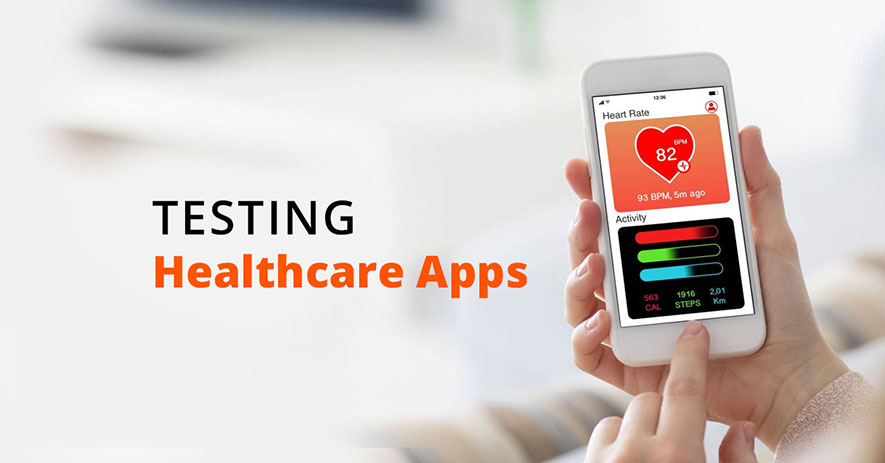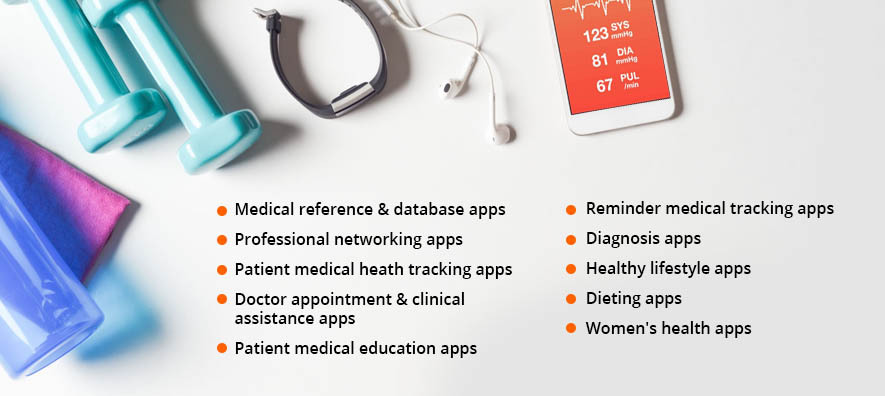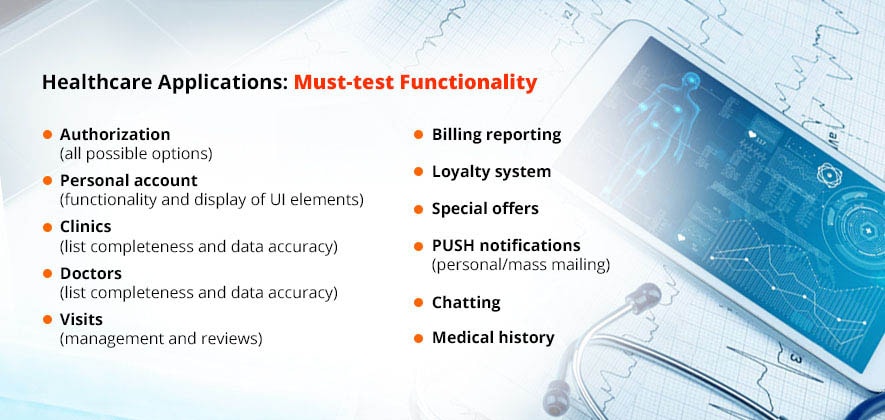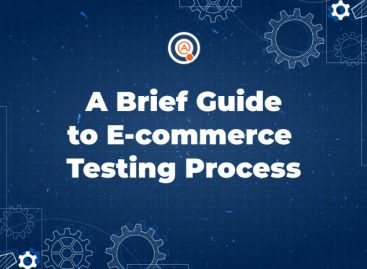- QATestLab Blog >
- QA for Business >
- Industries Insights >
- How to Test a Healthcare App (and deal with every tech issue)
How to Test a Healthcare App (and deal with every tech issue)

The era of digitalization in healthcare is here.
Those who have already started exploring this lucrative domain, know that healthcare applications are unique. They require the utmost in precision and privacy. Innovations are also of great importance. And on top of everything else, they accept no flaws as human lives and well-being are at stake.
This kind of software undoubtedly demands the highest level of quality. In the article, we will outline the requirements for healthcare apps, list necessary testing types, and provide checklists and tips for the successful healthcare software testing process.
Healthcare Apps: Types, User Expectations & Tech Challenges
The HealthTech segment is diverse and evolving because of the market’s readiness to embrace the digital revolution. Patients turn into consumers. As a result, they demand transparency, convenience, and personalized products and services. They also want to have more control over personal healthcare data.
There are numerous apps that have managed to become indispensable for doctors and the general audience all over the world: from medical scheduling software to dieting apps. Find examples of healthcare application types below:

As we mentioned, innovation is the key force accelerating the development of healthcare technology. Like, for example, AI-powered chatbots or cloud computing. Private cloud systems are widely used for security-sensitive cases, such as pharmacy orders or patient bills. Speaking of data safety, it is necessary to emphasize the role of blockchain systems that guarantee extra security and integrity when it comes to the patient’s health records storage, distribution, and shared access.
The list of innovations implemented in HealthTech may also include Big Data, Internet of Medical Things (IoMT), and AR/VR.
The other force that keeps pushing this market forward is customer expectations.
- First of all, they expect increased speed and cost-efficiency in receiving healthcare services. For many, it would be more convenient to get regular check-ups online, so telemedicine apps should be super performant and feature-rich.
- Customers also want to access medical services from everywhere, regardless of time or location.
- The precision of data is crucial for healthcare, and customers need to be sure they can trust the app they use. The integration of AI, ML, and advanced data analytics tech significantly contributes to achieving maximum accuracy.
- Next, convenient communication
- Finally, the possibility to track and control symptoms and share them with the doctor
Undoubtedly, modern technology can fulfill all of these requirements. However, developing high-quality, feature-rich, and up-to-date software is never easy. At the end of the day, customers trust the app with their health.
Some of the biggest challenges involved with healthcare applications are:
Design and accessibility
App design and architecture flaws can cause real harm when it comes to healthcare solutions. Even if it is only because of the lack of intuitiveness in navigation, no one wants to make the user of a medical app suffer even more. Moreover, healthcare solutions are ones that have the highest probability of being used by people with various kinds of disabilities. Usability testing should be conducted to assess the aforementioned qualities of the product.
Security and confidentiality of data
Healthcare applications contain different types of sensitive data, such as personal information and medical records. Its security is guaranteed by HIPAA (The Health Insurance Portability and Accountability Act). That is why it is crucial to develop and implement an effective security strategy that would also involve security testing. The app should get tested for security issues at every development stage, including each update to be released.
APIs and integrations
Every app requires interoperability to be part of the bigger healthcare technology system. It may consist of various devices, such as smartphones, smart wearables, fitness equipment, etc. The integration of different technologies and platforms requires all sorts of APIs to bridge this gap.
Multiple APIs integration is not easy. Sometimes it is necessary not only to execute the integration itself flawlessly but also to refine APIs logic to get the most of the UX. In this case, API testing would help to make sure everything has been done correctly.
Market trends
There are new trends in the healthcare tech industry that emerge year-to-year. The most exciting of them never go unnoticed by clinicians, patients, and investors. So app developers should deal with those changes. Deep learning, machine learning, IoT? The implementation of each new technology needs to be tested properly.
Maintenance and support
Maintenance, scalability, post-release testing support are important factors that should be considered before initiating the development process. Post-release testing support involves maximum coverage of the system coherence with each added functionality.
Healthcare Application Testing
Software testing is extremely important when it comes to medical and health-related apps. Bugs in healthcare solutions can cause serious consequences, penalties included. For example, HIPAA fines can reach up to $50,000 per violation.
The software testing strategy for healthcare apps should cover different system types, such as regulatory compliance, claims management, provider, financial, broker, and member systems.
The healthcare application testing process should involve the following testing types:
- positive and negative testing
- system integration testing
- functional testing
- verification of the mobile version
- compatibility testing
- cross-browser testing
- performance testing
- interoperability testing
- security testing
Mediocre understanding of the healthcare environment is among the main reasons why healthcare apps fail. That is why QA engineers need to have detailed specifications on what should be tested.
Healthcare App Testing Checklist: Must-Test Functionality
Let’s start with data security. The core aspects that require thorough examination are:
- Role-based access, e.g., API, client
- Authorization and authentication protocols, e.g., Oauth, token-based
- Key-based Authentication
- XSS / SQL injections
- Cache storage security, including keyboard, browser, solution
As for the rest, see the small cheat sheet we have prepared below:

Do not forget that all this functionality should be checked for software’s native, mobile, web, and hybrid versions.
Top tips to remember while checking the healthcare software
- QA engineers should dive deep into the software they test; healthcare apps are rather specific products and have hidden bottlenecks. Keep in mind the following tips while testing this kind of applications:
- Double-check the accuracy of the dates in apps. These are dates and times of appointment to a doctor, bills, recipes, etc., because even a small glitch can have consequences.
- While writing the test cases for health apps, remember additional parameters that are often missed: types of plans, calculations, providers, options of canceling the appointment, etc.
- Check if applications (e.g., web and mobile versions of health insurance applications) interact with each other and with the client’s electronic medical record.
Conclusion
We hope that the information presented here will come in handy to reveal the hidden issues in your application before the release. If you need help or additional information, visit our website or chat with QATestLab’s software testing experts right away.
Learn more from QATestLab
Related Posts:
About Article Author
view more articles
has 3-year experience in blogging, technical writing, and copywriting.
View More Articles







No Comments Yet!
You can be the one to start a conversation.